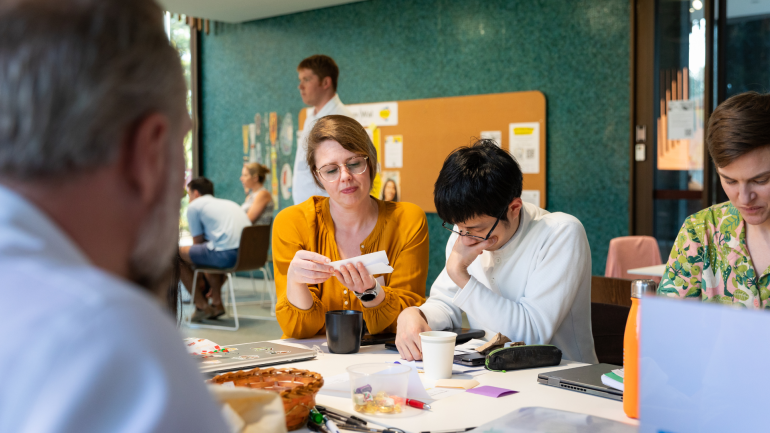Scholarship of Teaching and Learning (SoTL): Your new academic superpower
By Dr Anna Rowe (PVC Education Portfolio) and Dr Gabi Nudelman (UNSW Business School)
Published 30 September 2024
Have you heard the term “SoTL” but are not really sure what it means? In this blog post, we provide a brief overview of SoTL and three simple steps you can take to get your SoTL project started.
What is SoTL?
SoTL, which stands for the Scholarship of Teaching and Learning, involves researching how students learn within a discipline, as well as disseminating the findings of the research, so that others can learn from it and adapt the practices to their own teaching contexts (Healy, 2000).
SoTL also encompasses aspects of scholarly teaching; that is, being familiar with the latest thinking and ideas in a discipline, drawing on contemporary ideas for teaching within a discipline and reflecting on and evaluating teaching practices and student learning (Healy, 2000).
Scholarly teaching is important, because using evidence-based strategies can improve the quality of teaching, enhance student learning and promote ongoing reflection on and evaluation of teaching methods (see, for example, Kern, 2015; Smith & Baik, 2021). Engaging in scholarship is also a Tertiary Education Quality and Standards Agency (TEQSA) requirement, as academics are expected to engage in scholarship related to their discipline and teaching methods used in that discipline (TEQSA, 2022).
Being a scholarly teacher does not necessarily mean that all teaching academics are expected to do SoTL; however, UNSW staff are encouraged to engage in SoTL where it is appropriate to their role. SOTL can include both research and some forms of evaluation (for example, published impact-evaluation studies), with examples of SoTL including:
- published, peer-reviewed empirical research
- case studies
- literature reviews
- conference publications.
Kern et al. (2015) provide a useful framework distinguishing between scholarly teaching and SoTL activities. While many associate SoTL with “formal” dissemination outputs such as peer-reviewed journal articles, there are more informal ways to disseminate SoTL, such as blog posts, conference posters and presentations and internal reports. These can also count as SoTL – each discipline has different norms as to what type of outputs are most appropriate for your field.
Getting started with SoTL
While SoTL can seem daunting for those new to the discipline, the good news is that university educators already have the main tools needed for success. Most educators are curious, passionate and motivated to improve their teaching practice. These qualities underpin effective SoTL.
Follow these steps to get started on your SoTL project:
- Find a question that interests you
Higher education may be many things, but it’s never boring! An unending stream of challenges and conundrums influence teaching and learning in the sector, from micro-level classroom practices to global megatrends. These can provide rich inspiration for powerful questions.
To find your question, look at the academic world around you. Examine your classroom practices with a critical eye. Read policies and reports about higher education, paying attention to what stands out to you as interesting, unusual or problematic. Engage with your students about their academic experiences. Pay attention to any patterns that may arise when grading assessments. When you feel your curiosity being piqued, chances are you’re onto a promising question.
- Read what other people have written
Next, you want to dive into the literature that already exists about your question.
Critically, you want to make sure that your question hasn’t already been answered. However, this second step is also valuable because it can give you vital clues on how to answer it. Reading the literature will provide you with a sense of the scope of your question and methodologies, frameworks and theories that can help you locate your answer.
At this stage, you may find it necessary to reframe your question several times to integrate what you’ve been reading. Don’t be dispirited; this is a good thing, showing that your SoTL project is evolving!
- Identify what you’ll need to do to answer your question
The final step before you dive into your research is to determine what action you need to take to answer your question. Your options are wide, with SoTL-appropriate methodologies ranging from quantitative to qualitative to mixed-methods. Here are some possible methods that could help you answer your question:
- Conduct a systematic literature review; analyse policies; observe lectures and tutorials; interview educators; disseminate surveys; speak to students; run workshops.
Once you’ve completed these three simple steps, you’ll have set your SoTL project (and yourself!) up for success. Below we’ve added some extra tips to support your research.
Tips for SoTL success
- For guidance, reach out to colleagues who are active in the SoTL research space. You might also want to find a mentor.
- Consider building collaborative relationships with other like-minded academics. These can increase productivity and enjoyment.
- Remember that many SoTL projects will require human ethics research approval. Find more about UNSW’s ethics processes here.
- For SoTL support see the recently developed UNSW SoTL support page.
***
Reading this on a mobile? Scroll down to learn about the authors.
